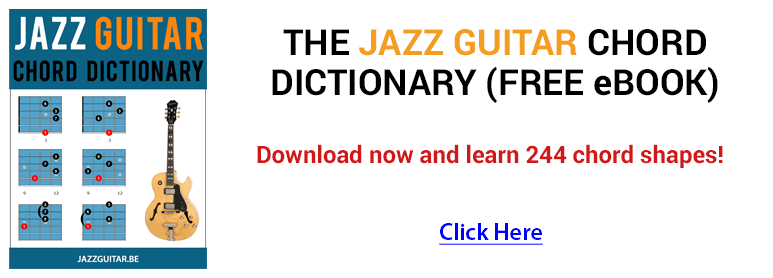-
Hi all,
Dec. 1st, time for our new tune...
A lead sheet for Have You Met Miss Jones can be found here:
557 jazz standards pdf
 Originally Posted by tonyknight
Originally Posted by tonyknight
Last edited by fep; 12-01-2010 at 10:58 AM.
-
12-01-2010 10:47 AM
-
Can't access youtube here at work, but I always liked the way Chet Baker did this one...
A great tune with a somewhat tricky B section. I'll dive in deeper here with analysis if there's some specific questions...
-
Not Guitar but it is an ensemble.
Tom
-
Nice job with all Frank... I'm have gigs all week, late Thur. and weekin, but I'll try and make quick analysis and video of how I play at different gigs... straight and a few hipper versions... again great job...should be cool. Best Reg
-
Let's try and not get to many versions up...How about only posting what your able to cover, or would realistically like to cover. Oilywrags sample is pretty simple and covers straight ahead version, maybe a blues version and one re-harm. and were done. Without having the basic version down... we'll start to miss the point. Just a suggestion... This is a Jazz Guitar Forum...Best Reg
-
Tom, aka oilywrag, made a great BIAB backing track for Have You Met Miss Jones. He asked me to post it on my Box.net account. You can hear it and download it from here:
Have you met miss jones.mp3 - File Shared from Box.net - Free Online File Storage
Last time we did this the backing track was used by intermediate/neophytes players, like me, to submit our playing for critique. I think that was a great excercise to go through.
Also, experts can use it, like Reg, as a backing track for their instructional examples etc.
So, use it for whatever you want.
-
Just to throw this out there: I love the parts of the melody that are purely scales. You're supposed to avoid being too scalar in melodies, eh? Measures 3-5 do an octave scale (D to D) and near the end, when the scale rises a 10th from C to E.
-
This is a fabulous idea - can't wait to see how this develops.
-
The best thing imo about I VI II V sort of 32 bar tunes is the exploration of progression when the A sections are pretty much just diatonic cadences. What can you play over I VI II V... well a lot.
Most lead sheets I see really have boring options for what to play. Mostly people are writing it F69/D7b9/Gm7/C7 etc. There are better option.
And then you get "Giant Steps" over the bridge (what commonly became Giant Steps only a semi-tone away).
I like playing this tune. I hope you guys dig ripping into it.
-
I love this tune,
This is how I see this tune:
In A1 and A2 sections the tune stays in the key center of F major and in the last 2 bars of the A2 it starts the fast key changes of ii V I in the B section changing in to Bb major, then F# major, D major then back to F# major and then back to the A3 again in the F major key center.
So a long linger on one key center on the A parts in contrast with the fast key centers in the B part.
-
Jay a question for you or anyone that would like to pick it up.The 2nd bar of the 1st A sec,how do you treat the F#Dim chord.Why is it F13b9 as the last chord before the Bsec when the melody is three 1/4 note D's.Finally why use a Bb7 at the end of the 4th bar of the last A sec.Other than that I would agree with your analysis.Hopefully Tony or Fep can post the analysis we did.
Thanks tom
-
Hi all,
I'm hoping we can use this chord progression for the tune as it is the same chords that Tom used for the backing track we have made available.
Of course, we can also discuss alternate chords and reharmanizations and substitutions.
-
My first question is what is the proper 'Jazz' Roman numeral analysis for the F#o7 in m.2?
Do you consider the F#o7 a sub for a VI7b9 (D7b9) chord? Or do you consider it a #Io7?
And what is proper Jazz Roman Numeral analysis for the Bb7 at m.22?
Do you consider the Bb7 simple a IV7 chord or do you consider it a tritone sub for a E7b9? Or do you think of it as simple a '1/2 step approach chord' to the Am7? The 1/2 step approach chord is the one I'm prefering at the moment, however I don't know how to notate that with Roman Numeral analysis.
Regardless, lydian dominant works well over the Bb7, or so my ear is telling me.Last edited by fep; 12-01-2010 at 07:04 PM.
-
F#dim must be a D7, (V of II), giving a I-VI-II-V start!
Sailor
-
F#dim7 in this instance is a sub chord for D7b9 which is really the proper chord that is most commonly played in this sort of progression.
#idim7 would be the accurate nomenclature for the chord as it's written here.
The Bb7 is a bII7/iii-7
The chord is a tri-tone sub passing chord to set up the A-7 chord (Bb7 = E7). This passing chord isn't extremely commonly played in my experience but that varies regionally in terms of how someone plays a tune that is as popular and common as this one.
Cap Roman's indicate a major third from the root is in the chords function (Maj7 and Dom7 chords). Lowercase for minor, diminished or other minor functions.
-
Hi Jake,
Thanks for that, so the change I need is on the Bb7 and for that I would use bII7/IIIm (or bII7/ii-7). I haven't seen this classical analysis convention used in Jazz analysis.
I use to use upper and lower case Roman Numerals as you described. But, I was corrected by Matt Warmock on this forum who said the current convention for Jazz is to use all upper case Roman Numerals. Originally Posted by Jake Hanlon
Originally Posted by Jake Hanlon
More recently I've been reading Jerry Coker's book 'hearin' the changes', in that book he said:
The jazz analysis usually omits the use of small case Roman Numerals, owing to the rather high frequency of chords which are altered from the structure that is formed naturally within the diatonic system. For example a chord built on the second degree of a major scale (as in D F A of a C major scale) is a minor chord, yet in tunes usied by jazz musuicians that chord often appears as a D7 ( a dominant seventh structure on II), ...Last edited by fep; 12-02-2010 at 01:59 AM.
-
BDLH cool observation, I even like it more that the scale run is played in 1/4th notes giving it kind of a "walking bass" groove
 Originally Posted by BigDaddyLoveHandles
Originally Posted by BigDaddyLoveHandles
-
Wow - fast start! Thanks Frank and everyone else for chiming in so quickly!!! And thanks, Tom, for a great backing track, although I have to admit that at best I can just about manage these changes at only 100bpm

A couple of quick questions. Can we have some sort of consensus on the use of Roman caps please as there appear to be two distinct schools of thought? In the previous thread we went back and forth on this, so perhaps not
Is that F#dim really a dim7 (F#, A, C, E) or a pure dim chord (F#, A, C, Eb)? The pure dim chord would be a direct sub for D7b9 (no root) ('D', F#, A, C, Eb). If I haven't made a mistake here, I'd suspect that the chord is a pure diminished F#...
To Jay: in your chord progression you suggest F#. Is there a right or wrong convention relative to using F# or Gb?
An observation: the F13b9 is interesting. As Tom said, it sits under a melody of Ds. If we were to play all the notes of this chord, we’d have 1+3+5+b7+b9+13 = F, A, C, Eb, Gb, D. So the melody makes this chord a 13th if we use a base of F major. Now, if we ignore the root, the F, we have that same F# diminished chord (if it is not a dim7) – there’s no way that this ‘coincidence’ would have escaped Rodgers… so I suspect the chord was chosen to echo or recall the earlier choice. Please correct me if my logic is flawed!!! Of course, if the dim7 is the true implied chord, then I could imagine that the 13th might be based on the major 7th triad and not the dominant 7th?
-
I think both are valid but, yes, the Gb seems a better choice as the ii V in the notation which lead to it are Ab and Db
 Originally Posted by tonyknight
Originally Posted by tonyknight
-
Hi Tony
Can you please type in a F13b9 fingering with graph? Thx
I m playing a straight F#dim on 2nd bar and looks good....
See ya
-
Hi MGranada, The best that I found was: 2x123x - which is very simplified as the notes are, respectively, the b9, b7, 3, 13 - so I left out the root and 5th. I'm sure that others can offer some alternatives as this is a bit of a challenge for me. It's rather like a standard form of 13th chord but with the sixth string raised one fret. The 'standard' F13 would be 1x123x. I'm putting together my first draft of the song (analysis, chords etc) which as you all know by now is an iterative process... Look for it shortly... Jay, thanks for the clarification.
-
 Originally Posted by fep
Originally Posted by fep
Matt certainly knows his stuff, but that must be pretty recent or in academia, because I haven't seen it with any of the cats I've played with recently (then again, their median age is in their 60's, so...)
-
shrugs I'd be happy to bend to Matt's theory chops. I'm probably just stuck in my ways of the older system

a II chord is a II chord either way. If you're specific about information after it like IIm7 then it pretty much doesn't matter
-
Thanks Mr. Beau and Jake - I guess I'll just follow that last piece of advice that a II chord is still a II chord and can be made more specific with the addition of 'm' for minor... unitl someone chimes in with a well argued complaint

-
+1
 Originally Posted by Jake Hanlon
Originally Posted by Jake Hanlon
Completely agree, both ways communicate the information effectively.
I've just decided to pick one and go with it. Since there isn't a consensus, I certainly don't want to change my posts back and forth everytime a professor corrects my work... Now if I was in your class, I'd happily do it your way
We still have what Jerry Coker wrote, which I quoted directly from his book. At this point I just feel there are two conventions, neither is better than the other. But now I'm leaning to going back to upper and lower case.Last edited by fep; 12-02-2010 at 11:03 AM.




 Reply With Quote
Reply With Quote



"Dobbie Donnakis" - Daniel DeLorenzo - Submission...
Yesterday, 11:46 PM in Everything Else